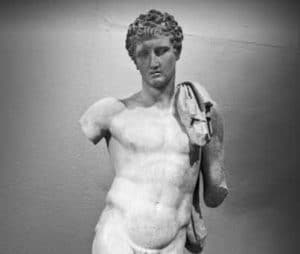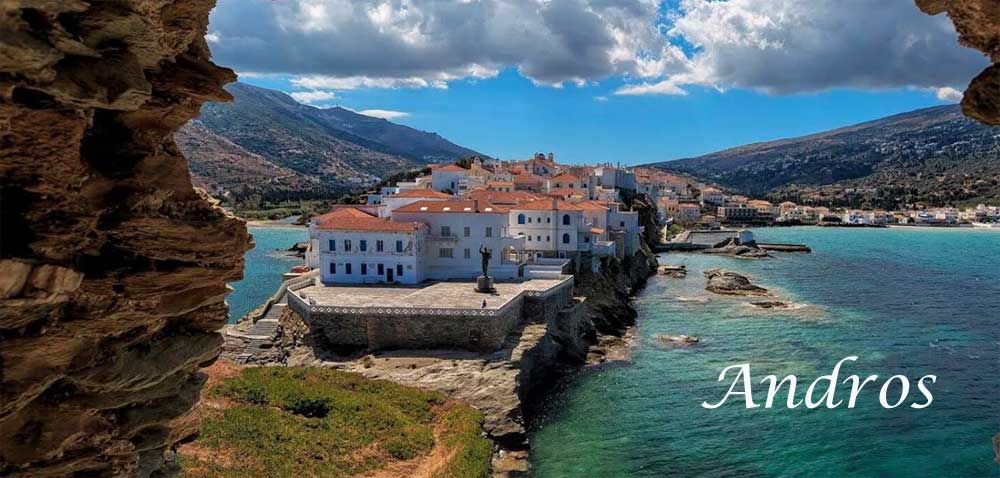History of Andros

There are very few cultural finds of the Stone and Bronze Age, which certify the existence of a prehistoric settlement on the island.
We derive our knowledge from mythological traditions. The named settler and first king of the island was Andros. Later it was settled by the Pelasgians.
During historical times, the island was inhabited by Iones, who may have come from Athens, as Thucydides mentions. The Latin Plinius the Elder saved some of the names that were given to Andros. Callimachus calls the island Lasia and others Hydrousa. These names attribute more to the natural characteristics of Andros, the vegetation, the waters, etc.
Important information about Andros during the Geometric Age was offered by the discovery of an important settlement, rare for archaic times, in the area of Zagora. The settlement flourished in the period 700-500 BC, but its life, as it seems, ended abruptly.
In Zagora, 45 rectangular spaces-rooms with storerooms and courtyards, built with the timeless Andriotian material, slate, were discovered. The floors were covered with a layer of pressed clay, as was customary until recently. Wooden beams and slate slabs supported the clay layers of the roof.
A remarkable building of the settlement was also the later temple, which was probably dedicated to the worship of Athena.
Αncient times
During the 7th BC century, Andros was the metropolis of four important colonies in the area of Halkidiki and the Strymonian Gulf. They were the colonies of Akanthos, Sani, Stageiros and Argillos. According to Herodotus, during the Persian Wars, the Andrians, like the other islanders, are said to have “plucked”, providing “land and water” to the Persians.
Center, key city and source of information for us, is for classical times the settlement that was built on the site of today’s Paleopolis. The city is said to have been founded in 700 BC. approximately, when the settlement of Zagora was abandoned.
Systematic excavations have not yet been carried out. Accidental, but important finds are the Hermes of Andros (a copy from Hellenistic times) and the metrical hymn to the goddess Isis, which still serves as a lintel of a house in Paleopolis.
There was also a citadel, a port, a market and a competent fortification. About 60 silver and copper coins have been saved, many of which depict Dionysus, the beloved god of Andros.
Andros during the Peloponnesian War
During the Peloponnesian War, Andros lined up with ships and hoplites on the side of the Athenian allies. As a member of the Athenian alliance he paid 72000 drachmas (12 talents) as an island tax to the alliance treasury.
In 411 BC the Andrians defected from Athens, sided with Sparta, but returned and joined the Second Athenian League in 378 BC.
After the battle in Chaeronea, in 338 BC, where they fight alongside the Athenians, the city-state of Andros came under Macedonian rule.
Hellenistic Period
During the Hellenistic historical period, following the death of Alexander the Great, Andros first came under direct Macedonian control and participated in the community of the islanders.
From 315 BC until 31 BC, it passed successively under Roman, Macedonian, Ptolemaic and second Macedonian rule, under Demetrius. In 199 BC Roman and Parchment troops landed, besieged and sacked Paleopolis.
Andros remained under the Pergamum of the Attalids until it was ceded to the Romans. An important monument of the Hellenistic times is the tower of Agios Petros.
Byzantine period
In the early Byzantine years, Andros was administratively included in the province of Islands (with Rhodes as its capital). Christianity spread from the first centuries to its inhabitants.
Its geographical position on the main sea route to Constantinople, as well as the need to protect the empire from Arab pirate attacks, made Andros an important administrative center of the “Aegean Sea Issue” and the seat of imperial customs. The economic and intellectual prosperity of the period was similar.
We know that around 820 AD Leo the Mathematician was taught rhetoric, philosophy and mathematics in Andros, and studied the rich monastic libraries of the island.
The 12th century, the period of the Komnenian dynasty, is the most documented era for the island. Valuable information is provided by foreign travelers who stopped there on their journey to the Holy Land.
Andros in 1204, sericulture and the processing of silk in general was the main occupation of the inhabitants. The most sought-after were men’s steamed silks, luxurious heavy fabrics, but also the spider-like zentata, as well as the skins, which were fine gold threads.
However, despite the general prosperity, we know that enemy raids continued. Venetians, Normans, Genoese repeatedly attacked and plundered the place.
With the conquest of Constantinople by the crusaders, Andros fell to the lot of the Venetians. In 1207 it was granted to Marino Dandolo, a relative of the Doge of Venice and remained under their rule until 1566. The Venetians, in order to protect the island from successive pirate raids and from the Turks, built defense towers, castles, vigles.
The first and main fortress, military and administrative center of the Venetian dynasty, was Mesa Kastro, which was also the first core of the later Kato Kastro , the medieval settlement of today’s Chora. The current name of Riva survived from the time of the Venetians, as the main dock of Chora was located in this area.
Ottoman period
The Turkish conquest of Andros took place in 1566 after the consent of its inhabitants. This fact of voluntary subjugation provided special privileges to the island. The real administration in the place until the 17th century was exercised by the descendants of Byzantine, Frankish and Andriotian families, who had adopted the feudal Venetian system.
Andros and later enjoyed favorable treatment from the Ottomans. From the 18th century it belonged as a “malikianess”, a kind of fiefdom, to Wadile Sultana and in 1778 to the sister of Selim III, Shah Sultana.
The Andriotes paid fixed taxes and were exempted from chores and other payments, they were protected from any Ottoman interventions, they had secured their free trade and their inheritance rights.
In the period 1770-1777, Andros, like the other Cyclades, was controlled by the Russians through a local lord, the so-called chancellor. With the departure of the Russians, the institution of kojambasi was introduced to Andros for the first time. The kotzabasides of Kato Kastro and Korthi were prosperous landowners. Most of the time they were elected for one year and were the real commanders of Andros.
The economy of the place continued to be agricultural, but in Kato Kastro a new class of sailors had begun to develop, the “gemitzides”, who in the 19th century already put forward their own claims. In 1813 Andros had 40 ships with a capacity of 2800 tons and about 400 sailors.
In the first years of the Turkish rule, the information mentions the operation of a school, that of the Capuchin monks, which was founded in the 17th century. In 1768 the archbishop of Andros Dionysios Kairis created the “School of Greek Letters”. In Korthi since 1814 the school of Agia Triada was operating
Recent History
In May 1821, after a gathering of the people, it was decided that the people of Andriot would participate in the struggle of the enslaved Genus, with warriors, money and warships.
From 1822 to 1828, social movements broke out on the island, such as that of Dimitrios Bali, with the main reasons being the unbearable taxation imposed by the local lords.
The island also suffered from the disembarkation of unruly troops of the “liapides”, who mainly terrorized the inhabitants of the villages.
In the Ottoman years, the leapfrog development of shipping in Andros is observed, which after 1880 was converted from a sailing vessel to a steam vessel, according to the new requirements. Men’s shipping managed to overcome the crisis of the two World Wars and is to this day a key source of wealth for the place.
